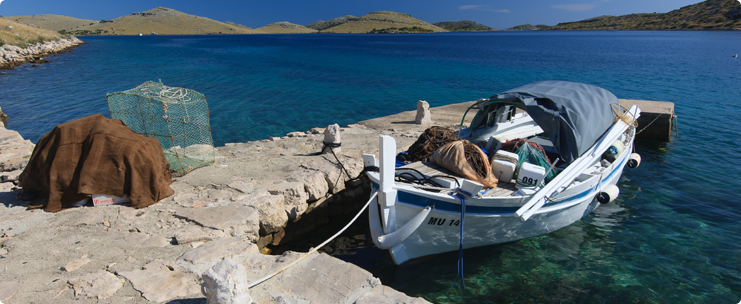The living space of Murter and Betina (arable land and pastures) stretches to several locations, mutually distant and separated by the sea: the Murter reefs (small islets along the island), Modrave (olive orchards on the mainland, along what is now the main coastal road), Makirina (mainland olive orchards, accessible by the sea), and then the Kornati, Žut and Sita, with all the islands and ports. As the shore in those locations didn't have any infrastructure to dock the boats, gajeta (the typical boat of the area) had to be so constructed to make a landfall literally anywhere.
However, it was much more difficult for the boat to satisfy the other requirements: size and handling characteristics. The boat had to be multifunctional. It means it had to be, figuratively speaking, a fisherman, a peasant and a labourer: as light as possible for fishing, as heavy and sturdy as possible for sailing, as voluminous as possible to carry goods and crops. In other words, it had to be three boats in one.
Another important feature was the boat's ease of handling, because gajeta was a family boat. What we mean is that the boat had to such that it could normally be handled by one healthy adult person and another member of the family, usually a weaker one, either a child or an old person.
 Gajeta and other larger or smaller boats were powered by a lateen sail and/or oars. Unlike the first square rigs from the Classical Antiquity which could sail only if the wind was abaft and unlike the modern sails rigged on tall masts, the lateen sail is set on a long yard mounted on the mast, lantina, and is triangular.The advantages of the sail were its comparatively easy handling, good behaviour when tacking and beating to the wind as well as easy raising or lowering.
Gajeta and other larger or smaller boats were powered by a lateen sail and/or oars. Unlike the first square rigs from the Classical Antiquity which could sail only if the wind was abaft and unlike the modern sails rigged on tall masts, the lateen sail is set on a long yard mounted on the mast, lantina, and is triangular.The advantages of the sail were its comparatively easy handling, good behaviour when tacking and beating to the wind as well as easy raising or lowering.
Gajeta was not easy to row and what were then oceanic distances to the Kornati ports, with an adverse current, took hours or even days to row. Much easier to row were small boats called kaić, both because of their size and because of a different construction. But the size was their shortcoming, too – they couldn't transport hay nor wood nor lard nor olives nor barrels of salted fish... Who had just a kaić had to borrow a gajeta, but they used to say that a boat was just like a woman, you don't lend her. One of the reasons was that each gajeta had her own mind, this one was weak on tack, another was heavy on oars, the third one was a bit unstable so the new sailor, unfamiliar with the boat's foibles could even have an accident. Many a gajeta had not only an official name, recorded in the papers, but also a nickname, either because of her peculiarities or because of the peculiarities of her owner.




